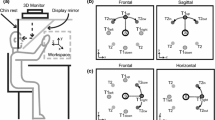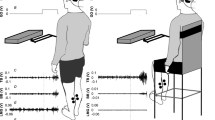Abstract
Reaching for an object while simultaneously rotating induces Coriolis and centrifugal inertial forces on the arm that require compensatory actions to maintain accuracy. We investigated whether the nervous system uses vestibular signals of head rotation to predict inertial forces. Human subjects reached in darkness to a remembered target 33 cm distant. Subjects were stationary, but experienced a strong vestibular rotation signal. We achieved this by rotating subjects at 360°/s in yaw for 2 min and then stopping, and subjects reached during the ‘post-rotary’ period when the deceleration is interpreted by the vestibular system as a rotation in the opposite direction. Arm trajectories were straight in control trials without a rotary stimulus. With vestibular stimulation, trajectory curvature increased an average of 3 cm in the direction of the vestibular stimulation (e.g., to the right for a rightward yaw stimulus). Vestibular-induced curvature returned rapidly to normal, with an average time constant of 6 s. Movements also became longer as the vestibular stimulus diminished, and returned towards normal length with an average time constant of 5.6 s. In a second experiment we compared reaching with preferred and non-preferred hands, and found that they were similarly affected by vestibular stimulation. The reach curvatures were in the expected direction if the nervous system anticipated and attempted to counteract the presence of Coriolis forces based on the vestibular signals. Similarly, the shorter reaches may have occurred because the nervous system was attempting to compensate for an expected centrifugal force. Since vestibular stimulation also alters the perceived location of targets, vestibular signals probably influence all stages of the sensorimotor pathway transforming the desired goal of a reach into specific motor-unit innervation.







Similar content being viewed by others
References
Abend W, Bizzi E, Morasso P (1982) Human arm trajectory formation. Brain 105:331–348
Andersen RA, Shenoy KV, Snyder LH, Bradley DC, Crowell JA (1999) The contributions of vestibular signals to the representations of space in the posterior parietal cortex. Ann N Y Acad Sci 871:282–292
Augurelle AS, Penta M, White O, Thonnard JL (2003) The effects of a change in gravity on the dynamics of prehension. Exp Brain Res 148:533–540
Bagesteiro LB, Sainburg RL (2002) Handedness: dominant arm advantages in control of limb dynamics. J Neurophysiol 88:2408–2421
Bagesteiro LB, Sainburg RL (2003) Nondominant arm advantages in load compensation during rapid elbow joint movements. J Neurophysiol 90:1503–1513
Barany R (1910) Neue Untersuchungsmethoden, die Beziehungen zwischen Vestibularapparat, Kleinhirn, Grosshirn, und Rückenmark betreffend. Wien med Wschr 60:2033
Bottini G, Sterzi R, Paulesu E, Vallar G, Cappa SF, Erminio F, Passingham RE, Frith CD, Frackowiak RS (1994) Identification of the central vestibular projections in man: a positron emission tomography activation study. Exp Brain Res 99:164–169
Bresciani JP, Blouin J, Popov K, Bourdin C, Sarlegna F, Vercher JL, Gauthier GM (2002a) Galvanic vestibular stimulation in humans produces online arm movement deviations when reaching towards memorized visual targets. Neurosci Lett 318:34–38
Bresciani JP, Blouin J, Sarlegna F, Bourdin C, Vercher JL, Gauthier GM (2002b) On-line versus off-line vestibular-evoked control of goal-directed arm movements. NeuroReport 13:1563–1566
Bresciani JP, Gauthier GM, Vercher JL, Blouin J (2005) On the nature of the vestibular control of arm-reaching movements during whole-body rotations. Exp Brain Res 164:431–441
Cohn JV, DiZio P, Lackner JR (2000) Reaching during virtual rotation: context specific compensations for expected coriolis forces. J Neurophysiol 83:3230–3240
Desmurget M, Grafton S (2000) Forward modeling allows feedback control for fast reaching movements. Trends Cogn Sci 4:423–431
DiZio P, Lackner JR (1995) Motor adaptation to Coriolis force perturbations of reaching movements: endpoint but not trajectory adaptation transfers to the nonexposed arm. J Neurophysiol 74:1787–1792
DiZio P, Lackner JR (2001) Coriolis-force-induced trajectory and endpoint deviations in the reaching movements of labyrinthine-defective subjects. J Neurophysiol 85:784–789
Fisk J, Lackner JR, DiZio P (1993) Gravitoinertial force level influences arm movement control. J Neurophysiol 69:504–511
Flanders M, Hondzinski JM, Soechting JF, Jackson JC (2003) Using arm configuration to learn the effects of gyroscopes and other devices. J Neurophysiol 89:450–459
Goodbody SJ, Wolpert DM (1999) The effect of visuomotor displacements on arm movement paths. Exp Brain Res 127:213–223
Gribble PL, Ostry DJ (1999) Compensation for interaction torques during single- and multijoint limb movement. J Neurophysiol 82:2310–2326
Guldin WO, Gruesser OJ (1998) Is there a vestibular cortex? Trends Neurosci 21:254–259
Guldin WO, Akbarian S, Gruesser O (1992) Cortico-cortical connections and cytoarchitectonics of the primate vestibular cortex: a study in squirrel monkeys (saimiri sciureus). Comp Neurol 326:375–401
Hain TC, Ramaswamy TS, Hillman MA (2000) Anatomy and physiology of the normal vestibular system. In: Herdman SJ (ed) Vestibular rehabilitation. F.A. Davis Company, Philadelphia, pp 3–24
Hatsopoulos N, Joshi J, O’Leary JG (2004) Decoding continuous and discrete motor behaviors using motor and premotor cortical ensembles. J Neurophysiol 92:1165–1174
Hietanen JK, Perrett DI (1996) Motion sensitive cells in the macaque superior temporal polysensory area: response discrimination between self-generated and externally generated pattern motion. Behav Brain Res 76:155–167
Hollerbach MJ, Flash T (1982) Dynamic interactions between limb segments during planar arm movement. Biol Cybern 44:67–77
Huffman KJ, Krubitzer L (2001) Area 3a: topographic organization and cortical connections in marmoset monkeys. Cereb Cortex 11:849–867
Johnson PB, Ferraina S, Bianchi L, Caminiti R (1996) Cortical networks for visual reaching: physiological and anatomical organization of frontal and parietal lobe arm regions. Cereb Cortex 6:102–119
Kalaska JF, Cohen DA, Prud’homme M, Hyde ML (1990) Parietal area 5 neuronal activity encodes movement kinematics, not movement dynamics. Exp Brain Res 80:351–364
Kalaska JF, Scott SH, Cisek P, Sergio LE (1997) Cortical control of reaching movements. Curr Opin Neurobiol 7:849–859
Karnath HO, Sievering D, Fetter M (1994) The interactive contribution of neck muscle proprioception and vestibular stimulation to subjective “straight ahead” orientation in man. Exp Brain Res 101:140–146
Kawano K, Sasaki M, Yamashita M (1984) Response properties of neurons in posterior parietal cortex of monkey during visual-vestibular stimulation. I. Visual tracking neurons. J Neurophysiol 51:340–351
Kleinbaum DG, Kupper LL, Muller KE (1988) Applied regression analysis and other multivariable methods. PWS-Kent, Boston
Lackner JR, DiZio P (1994) Rapid adaptation to Coriolis force perturbations of arm trajectory. J Neurophysiol 72:299–313
Lackner JR, DiZio P (1998a) Adaptation in a rotating artificial gravity environment. Brain Res Brain Res Rev 28:194–202
Lackner JR, DiZio P (1998b) Gravitoinertial force background level affects adaptation to coriolis force perturbations of reaching movements. J Neurophysiol 80:546–553
Lobel E, Kleine JF, Bihan DL, Leroy-Willig A, Berthoz A (1998) Functional MRI of galvanic vestibular stimulation. J Neurophysiol 80:2699–2709
Mars F, Archambault PS, Feldman AG (2003) Vestibular contribution to combined arm and trunk motion. Exp Brain Res 150:515–519
Morasso P (1981) Spatial control of arm movements. Exp Brain Res 42:223–227
Nowak DA, Hermsdorfer J, Schneider E, Glasauer S (2004) Moving objects in a rotating environment: rapid prediction of Coriolis and centrifugal force perturbations. Exp Brain Res 157:241–254
Papaxanthis C, Pozzo T, Schieppati M (2003) Trajectories of arm pointing movements on the sagittal plane vary with both direction and speed. Exp Brain Res 148:498–503
Pigeon P, Bortolami SB, DiZio P, Lackner JR (2003) Coordinated turn-and-reach movements. I. Anticipatory compensation for self-generated coriolis and interaction torques. J Neurophysiol 89:276–289
Raphan T, Matsuo V, Cohen B (1979) Velocity storage in the vestibulo-ocular reflex arc (VOR). Exp Brain Res 35:229–248
Sainburg RL (2002) Evidence for a dynamic-dominance hypothesis of handedness. Exp Brain Res 142:241–258
Sainburg RL, Kalakanis D (2000) Differences in control of limb dynamics during dominant and nondominant arm reaching. J Neurophysiol 83:2661–2675
Sainburg RL, Ghilardi MF, Poizner H, Ghez C (1995) Control of limb dynamics in normal subjects and patients without proprioception. J Neurophysiol 73:820–835
Scott SH, Kalaska JF (1997) Reaching movements with similar hand paths but different arm orientations. I. Activity of individual cells in motor cortex. J Neurophysiol 77:826–852
Scott SH, Sergio LE, Kalaska JF (1997) Reaching movements with similar hand paths but different arm orientations. II. Activity of individual cells in dorsal premotor cortex and parietal area 5. J Neurophysiol 78:2413–2426
Shadmehr R, Mussa-Ivaldi FA (1994) Adaptive representation of dynamics during learning of a motor task. J Neurosci 14:3208–3224
Wilson VJ, Melvill J (1979) Mammalian vestibular physiology. Plenum Press, New York, London
Winter DA (2005) Biomechanics and motor control of human movement. Wiley, Hoboken
Wise SP, Boussaoud D, Johnson PB, Caminiti R (1997) Premotor and parietal cortex: corticocortical connectivity and combinatorial computations. Annu Rev Neurosci 20:25–42
Acknowledgments
We thank A. Züger for excellent technical support. Supported by the Swiss National Science Foundation [3100–063669], the Olga-Mayenfisch Foundation, the Hartmann-Mueller Foundation, and the Betty and David Koetser Foundation for Brain Research, Zürich, Switzerland.
Author information
Authors and Affiliations
Corresponding author
Rights and permissions
About this article
Cite this article
Bockisch, C.J., Haslwanter, T. Vestibular contribution to the planning of reach trajectories. Exp Brain Res 182, 387–397 (2007). https://doi.org/10.1007/s00221-007-0997-x
Received:
Accepted:
Published:
Issue Date:
DOI: https://doi.org/10.1007/s00221-007-0997-x




